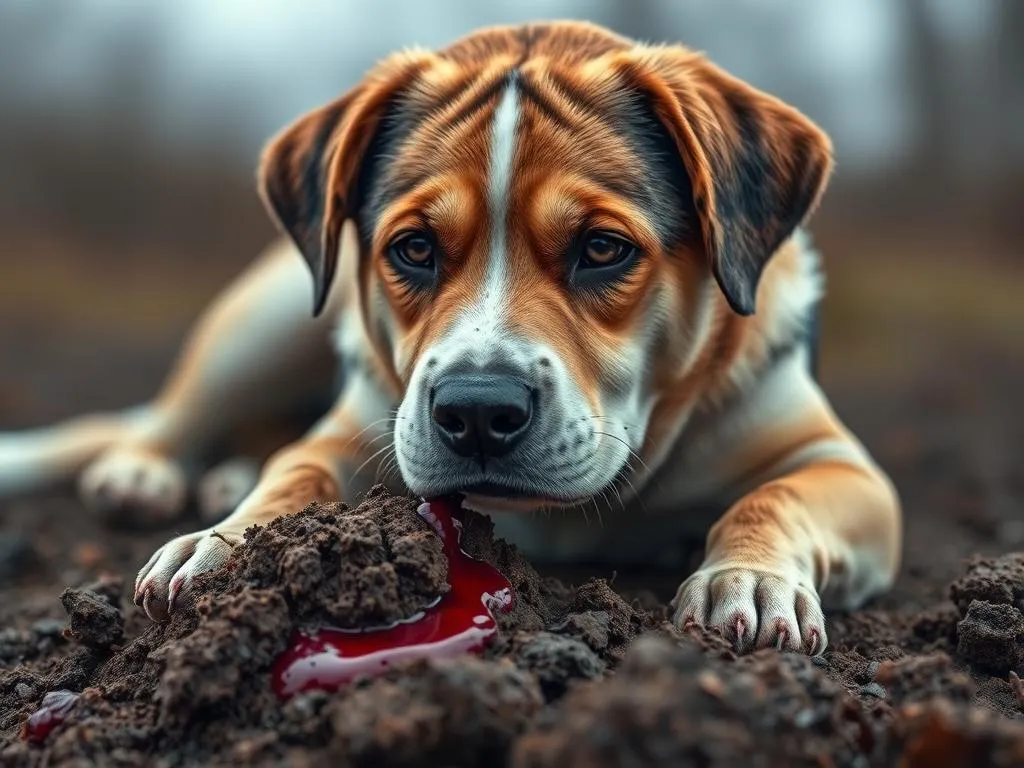
Monitoring your dog’s health is crucial for their overall well-being. One of the alarming signs that pet owners may notice is blood in dogs’ poop. This symptom can indicate various health issues, ranging from minor problems to severe conditions. Understanding the significance of this symptom is essential for timely veterinary care. Here’s an in-depth look at what could be causing this issue and what steps you should take if you notice it.
Understanding Blood in Dog Poop
What Does Blood in Dog Poop Look Like?
When assessing blood in dogs’ poop, the first thing to consider is the color and consistency of the blood. Blood can appear in two primary forms:
-
Bright Red Blood: This typically indicates that the bleeding is occurring in the lower gastrointestinal tract, such as the colon or rectum. If you notice bright red streaks or spots in the stool, this could be a sign of issues like hemorrhoids, colitis, or other local injuries.
-
Dark or Black Blood: This is often a sign of bleeding in the upper gastrointestinal tract, such as the stomach or small intestine. Blood that has been digested will appear dark and tarry. If you see this in your dog’s stool, it may indicate more serious conditions, such as ulcers or tumors.
Possible Locations of Bleeding
Understanding where the bleeding is occurring can help you and your veterinarian identify the underlying issue.
-
Upper Gastrointestinal Tract: Blood from this area tends to be digested, resulting in dark, tarry stools (melena). Conditions such as ulcers, tumors, or severe infections may be the cause.
-
Lower Gastrointestinal Tract: Blood here is usually bright red and may be mixed with mucus. Causes can include infections, inflammatory bowel disease, or rectal injuries.
Common Causes of Blood in Dogs’ Poop
Gastrointestinal Issues
Infections: Bacterial, viral, or parasitic infections can lead to inflammation and bleeding in the gastrointestinal tract. Common culprits include parvovirus, salmonella, and hookworms.
Inflammatory Bowel Disease (IBD): IBD is a chronic condition that causes inflammation in the digestive tract. Symptoms often include diarrhea (which may contain blood), vomiting, weight loss, and a decreased appetite. Diagnosis typically involves blood tests and possibly biopsies.
Dietary Indiscretion: Dogs are notorious for eating things they shouldn’t. Consuming foreign objects, spoiled food, or toxic substances can lead to gastrointestinal distress and bleeding. Symptoms may include vomiting, diarrhea, and abdominal pain.
Other Health Conditions
Tumors or Cancer: Various types of cancers can cause gastrointestinal bleeding. Tumors may obstruct the digestive tract or invade blood vessels, leading to bleeding that could manifest as blood in dogs’ poop.
Blood Clotting Disorders: Conditions like von Willebrand disease can impair a dog’s ability to clot blood, resulting in bleeding from various sites, including the gastrointestinal tract.
Liver Disease: The liver plays a significant role in blood clotting. Liver disease can lead to an increased risk of bleeding, which may be reflected in the stool.
Toxic Ingestion
Many household items are toxic to dogs and can lead to severe gastrointestinal issues. Common toxic substances include:
- Chocolate
- Grapes and raisins
- Xylitol (found in sugar-free products)
- Certain medications (like NSAIDs)
Symptoms of toxicity can vary widely but often include vomiting, diarrhea, and lethargy.
Identifying Accompanying Symptoms
Gastrointestinal Symptoms
When evaluating your dog for blood in poop, pay close attention to other gastrointestinal symptoms. These can include:
- Diarrhea: Watery stools may be a sign of infection or dietary issues.
- Vomiting: Frequent vomiting can indicate a more severe underlying condition.
- Changes in Appetite: A sudden decrease in appetite can signal discomfort or illness.
Behavioral Changes
Behavioral changes can also provide important clues about your dog’s health:
- Lethargy: Unusual tiredness or lack of energy can indicate that your dog is not feeling well.
- Signs of Pain or Discomfort: Whining, pacing, or reluctance to move may suggest abdominal pain.
- Changes in Drinking Habits: Increased or decreased thirst can indicate various health issues.
Urgent Symptoms
Recognizing a medical emergency is crucial. Seek immediate veterinary care if you notice:
- Excessive vomiting, especially if it contains blood.
- Collapse or severe lethargy.
- Signs of severe abdominal pain (e.g., whining, restlessness).
Diagnosis and Veterinary Care
When to Contact Your Veterinarian
If you notice blood in your dog’s poop, it’s essential to contact your veterinarian promptly. Guidelines include:
- Immediate Contact: If the blood is bright red, or if there are accompanying urgent symptoms like vomiting or lethargy.
- Observation: If the blood is dark or the dog shows no other symptoms, monitor closely, but still contact your vet within 24 hours.
When you call, provide detailed information about your dog’s symptoms, behavior, and any recent changes in diet or environment.
Diagnostic Procedures
Your veterinarian may recommend several tests to diagnose the underlying issue:
- Fecal Exam: To check for parasites or infections.
- Blood Tests: To assess overall health and check for signs of infection or bleeding disorders.
- Imaging: X-rays or ultrasounds may be necessary to visualize internal organs and identify potential obstructions or tumors.
Treatment Options
Treatment will depend on the underlying cause of the bleeding:
- Medications: Antibiotics for infections, anti-inflammatory medications for IBD, or medications to promote clotting for bleeding disorders.
- Surgery: In cases of tumors, severe obstructions, or foreign body ingestion, surgical intervention may be necessary.
- Dietary Changes: Your vet may recommend a special diet to promote healing and reduce gastrointestinal irritation.
Following your veterinarian’s recommendations is crucial for your dog’s recovery.
Preventive Measures
Regular Veterinary Check-ups
Routine veterinary visits are vital for early detection of health issues. Regular vaccinations and preventive care can help keep your dog healthy and reduce the risk of infections and diseases that could lead to blood in dogs’ poop.
Diet and Nutrition
Providing a balanced diet is essential for your dog’s health. Consider these tips:
- Quality Commercial Dog Food: Choose high-quality, well-balanced food suitable for your dog’s age and size.
- Avoid Human Food: Many human foods can be harmful. Stick to dog-safe treats and snacks.
- Monitor Eating Habits: Be aware of any changes in your dog’s appetite or dietary habits.
Monitoring Behavior and Habits
Being vigilant about your dog’s behavior can help catch problems early:
- Daily Observations: Monitor your dog’s stool and behavior regularly.
- Health Journal: Keeping a health journal can be beneficial for tracking symptoms and changes over time, providing valuable information during vet visits.
Conclusion
Noticing blood in dogs’ poop can be alarming for any pet owner, but understanding its potential causes and implications is crucial. Regular monitoring of your dog’s health, prompt veterinary care, and preventive measures can help ensure your furry friend stays healthy and happy. Always remember, when in doubt, it’s better to consult your veterinarian for guidance.
FAQs
What should I do if I see blood in my dog’s poop?
Contact your veterinarian immediately, especially if the blood is bright red or accompanied by other symptoms like vomiting or lethargy.
Can stress cause blood in dog poop?
While stress itself may not directly cause bleeding, it can exacerbate underlying issues like inflammatory bowel disease, leading to symptoms that include blood in dogs’ poop.
Is blood in dog poop always a sign of a serious issue?
Not necessarily, but it should always be taken seriously. Minor issues like dietary indiscretion can cause bleeding, but it’s essential to rule out more severe conditions.
How can I prevent blood in my dog’s poop in the future?
Regular veterinary check-ups, a balanced diet, and monitoring your dog’s behavior and habits can help prevent issues that may lead to blood in dogs’ poop. Avoid giving your dog harmful foods or allowing them to ingest foreign objects.
By staying vigilant and proactive about your dog’s health, you can help ensure that any potential issues are addressed promptly, keeping your furry friend safe and healthy.









